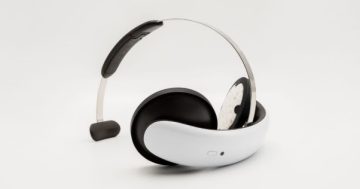Grace Browne* says Synchron has implanted its BCI in a US patient for the first time—bringing it a big step closer to distribution.
 Thomas Oxley has a love-hate relationship with Black Mirror. On the one hand, he can appreciate the show’s “gripping” appeal.
Thomas Oxley has a love-hate relationship with Black Mirror. On the one hand, he can appreciate the show’s “gripping” appeal.
On the other hand, it means facing a deluge of accusations that he’s spearheading humanity’s dystopian future.
Oxley is the founder and CEO of Synchron, a company creating a brain-computer interface, or BCI.
These devices work by eavesdropping on the signals emanating from your brain and converting them into commands that then enact a movement, like moving a robotic arm or a cursor on a screen.
The implant essentially acts as an intermediary between mind and computer.
“[Black Mirror is] so negative, and so dystopian.
“It’s gone to the absolute worst-case scenario … so much good stuff would have happened to have gotten to that point,” he says, referring to episodes of the show that demonstrate BCI technology being used in ethically dubious ways, such as to record and replay memories.
The “good stuff” is what Oxley is trying to do with his company.
And on July 6, the first patient in the US was implanted with Synchron’s device at a hospital in New York.
(The male patient, who has lost the ability to move and speak as a result of having amyotrophic lateral sclerosis—a progressive disease that affects nerve cells— has requested anonymity on the basis that he did not wish to promote the device before “experiencing its pros and cons.”)
The device promises patients the ability to control the mouse of their personal computer and use it to click.
That simple movement could allow them to text their doctor, shop online, or send an email.
The digital world has already seeped into every corner of modern human existence, providing all sorts of services —“but to use them, you need to use your fingers,” Oxley says.
For the estimated 5.6 million people living with a form of paralysis in the United States, that access isn’t always available.
After the intense media coverage devoted to Elon Musk’s BCI company, Neuralink, you’d be forgiven for thinking the technology is a novel scientific innovation.
In reality, it has been around for a couple of decades.
But apart from Synchron’s, the only other BCI approved by the US Food and Drug Administration for testing in clinical trials is the Utah array, a tiny device consisting of a series of electrodes that gets implanted in the brain.
Implantation requires cutting open the scalp and drilling into the skull.
“It’s a very invasive thing; it’s not something that you do recreationally—unless you’re really into weird things,” says Konrad Kording, a computational neuroscientist at the University of Pennsylvania.
The real novelty with Synchron’s device, he says, is that surgeons don’t have to cut open your brain, making it far less invasive, and therefore less risky for patients.
The device, called a Stentrode, has a mesh-like design and is about the length of a AAA battery.
It is implanted endovascularly, meaning it’s placed into a blood vessel in the brain, in the region known as the motor cortex, which controls movement.
Insertion involves cutting into the jugular vein in the neck, snaking a catheter in, and feeding the device through it all the way up into the brain, where, when the catheter is removed, it opens up like a flower and nestles itself into the blood vessel’s wall.
Most neurosurgeons are already up to speed on the basic approach required to put it in, which reduces a high-risk surgery to a procedure that could send the patient home the very same day.
“And that is the big innovation,” Kording says.
Synchron is making tangible progress.
In August 2020, the company was granted an investigational device exemption from the FDA, allowing it to become the first company to conduct clinical trials of a permanently implanted BCI.
To reach this point took five years and a “huge amount of work,” says Oxley.
A trial in Australia followed four patients who had been implanted with the device for 12 months and suggested that such prolonged use of the device was safe.
The company is now engaged in the safety and feasibility part of its testing—finding out if the procedure can be performed on multiple patients without serious side effects.
The trials also aim to determine how scalable the implant is—whether it could be implanted into everybody’s brain.
Synchron plans to implant the device into 15 patients before the end of 2022.
The next phase will be a pivotal trial, in which Synchron will have to show that the technology significantly improves aspects of its users’ lives.
This will involve consulting the patients themselves to find out what they hope to gain or regain with the implant.
Providing the trial goes to plan, the company will then apply for FDA approval and make a case for the device to be made available under Medicare, the government-provided health insurance program.
Going through Medicare is a key step toward making the device as accessible to as many people as possible, Oxley says.
He’s vague about the price of the implant, saying it will cost “in the order of magnitude of the cost of a car” (though he declined to say what kind of car).
But with the technology increasingly entering the commercial space comes a raft of ethical, legal, and social risks.
The device’s key ingredient is neural data, which also happens to be a highly sensitive bounty.
Questions naturally arise: How long should that data be stored, what should it be used for outside of the device’s immediate application, who owns the data, and who gets to do what they want with it?
“If this is private corporations with commercial interests in the data, is there anything kind of risky if it’s monopolized in one set of hands?” says Jennifer Chandler, a professor of law at the University of Ottawa who studies the intersection of the brain sciences, law, and ethics.
There are questions around what happens if the company runs out of money and goes under—do patients get to keep the device?
And if they want to get it taken out, would the company pay for removal?
But the various ethical landmines shouldn’t prohibit the technology moving ahead, Chandler says.
“My take would be: Be aware of the kinds of risks, pitfalls, challenges and address them early on and prepare, while pursuing the benefits of this as well.”
The mounting competitiveness in the BCI space yields positive and negative effects, says Ian Burkhart, who was implanted with a BCI a few years after a spinal cord injury left him paralysed from the chest down.
Burkhart helps lead the BCI Pioneers Coalition, a collective of BCI users who share their experiences.
The rush to market has meant things are getting done faster, and big names like Elon Musk have drawn attention to the field.
On the flipside, “you want to make sure that things are being done the right way,” says Burkhart.
“You have to have a little bit of good faith in these companies that they’re doing things for the right reasons.”
A big worry within the disabled community is that all the BCI hype will ultimately lead nowhere.
Another question on Burkhart’s mind is how long the device can last safely in the body.
Synchron’s device is permanently implanted, which Oxley says is crucial to making it commercially viable—but it’s also a factor that Burkhart thinks may put some patients off.
Oxley dreams of a million implants a year, which is how many stents and cardiac pacemakers are implanted annually.
That goal is about 15 to 20 years away, he figures.
And he appreciates the discourse surrounding the technology, even if it does irk him.
“What I want the world to understand is that this technology is going to help people,” he says.
“There seems to be a theme around the possible negative aspects of this technology or where it might go, but the reality is that people need this technology, and they need it now.”
*Grace Browne is a staff writer at WIRED, where she covers health.
This article first appeared at wired.co.uk.











